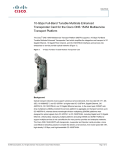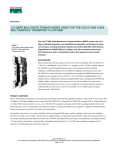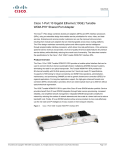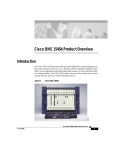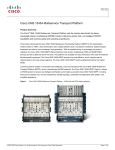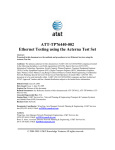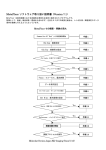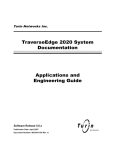Download Cisco OC-192/STM-64 Optics Card
Transcript
Data Sheet OC-192/STM-64 Line Card Portfolio for the Cisco ONS 15454 SONET/SDH Multiservice Provisioning Platforms ® The Cisco ONS 15454 SONET/SDH Multiservice Provisioning Platform (MSPP) supports a comprehensive suite of OC-192/STM-64 interface cards, allowing users to build cost-effective networks by matching the appropriate interface to the requirements of the network application. Figure 1. Single-Slot OC-192/STM-64 Line Card Background The need for 10 Gbps in the metropolitan-area network (MAN or metro) environment is driven by the transport network’s requirement for bandwidth that is larger than any single constituent signal from the edge, as well as the need to efficiently aggregate lower-speed services. 2.5-Gbps interfaces are becoming more common on edge switches, routers, and other transport platforms, and Gigabit Ethernet at the network edge is increasing in popularity. As a result, scaling the metro network to 10 Gbps is of increased interest to service providers that want to eliminate a service bottleneck through the metro. Metro networks must scale in bandwidth to meet larger service demands (OC-12/STM-4 and OC48/STM-16) while still efficiently supporting lower-rate services (such as DS-1/E1, DS-3/E3, and 10/100BASE-T). A metro transport platform incorporating 10-Gbps interfaces enables service providers to cost-effectively access increased revenue streams by being able to efficiently deliver the deployed, familiar, lower-rate services as well as the premium, higher-rate, Gigabit Ethernet and 2.5-Gbps services. Product Overview On the Cisco ONS 15454 MSPP, OC-192/STM-64 capabilities are provided through plug-in modules (Figure 1) providing interface specifications that meet the varied application needs of service provider or enterprise networks. Table 1 outlines the four OC-192/STM-64 plug-in module types available for the Cisco ONS 15454 MSPP, and the applications they support. All contents are Copyright © 1992–2006 Cisco Systems, Inc. All rights reserved. This document is Cisco Public Information. Page 1 of 11 Data Sheet Table 1. OC-192/STM-64 Modules with Applications Component Deployment Application Short-reach/intra-office Provides a cost-effective interface for interconnecting to transponder-based long-haul or metro dense wavelength-division multiplexing (DWDM) equipment. Intermediate-reach/shorthaul Suitable for metro interoffice connections between central offices, colocation offices, or enterprise and campus facilities with span lengths of less than 40 km. Long-reach/long-haul Suitable for metro interoffice connections between central offices, colocation offices, or enterprise and campus facilities with span lengths between 40 and 80 km. DWDM, Longreach/extended long-haul Primarily used in metro interoffice connections between central offices, colocation offices, or enterprise and campus facilities with bandwidth requirements exceeding 10 Gbps. Supporting 32 wavelengths, based on the International Telecommunication Union (ITU) frequency recommendations, the cards can be multiplexed together using optical filters (Cisco ONS 15454 MSTP, Cisco ONS 15216 or similar), allowing bandwidth scaling to 320 Gbps per fiber. Also suitable for use in single-channel applications that require extended reaches using optical amplification and dispersion compensation. Each version of the Cisco OC-192/STM-64 interface cards provides a SONET-compliant 9.95328Gbps high-speed interface. The transmitter and receiver reside on the same card and are interconnected to the fiber using standard SC connectors angled down relative to the faceplate to reduce stress on the optical fibers. The cards carry concatenated payloads of STS-3c/VC-4, STS6c/VC-4-2c, STS-12c/VC-4-4c, STS-24c/VC-4-8c, STS-48c/VC-4-16c, and OC-192c/VC-4-64c, as well as payloads on an STS-1, VC-3, VC-12, and VT1.5 basis. In SONET applications, the cards are software-provisionable to transport STM-64 SDH payloads in the form of STS-Nc-concatenated payload over SONET. When operated within the outlined specifications (Table 4), each card will transport the 10-Gbps signal with a minimum bite error rate (BER) of 10E-12. The Cisco OC-192/STM-64 cards are deployable in the four high-speed card slots of the Cisco ONS 15454 MSPP. The cards can be commissioned for use in Unidirectional Path Switched Ring/Sub-Network Connection Protection (UPSR/SNCP), two-fiber and four-fiber Bidirectional Line Switched Ring/Multiplex Section-Shared Protection Ring (BLSR/MS-SPR), 1+1 automatic protection switching/line multiplex section protection (APS/LMSP), or path-protected mesh network (PPMN) architectures, providing users with the flexibility to build the type of networks required to meet their service demands, traffic patterns, and application needs. This card-provisioning flexibility also helps to reduce the cost of inventory and simplifies engineering and deployment. The OC-192/STM-64 cards incorporate faceplate-mounted LEDs to provide a quick visual check of the operational status at the card. Printed on the faceplate is a blue triangle icon, which indicates the shelf slot where the card can be physically installed. The card is supported by the integrated Cisco Transport Controller craft manager for the Cisco ONS 15454 MSPP. The controller provides the user with access to operations, administration, maintenance, and provisioning (OAM&P) for the system. Application Description As broadband services are pushed closer to small offices and homes, higher capacities are needed in the modern metro optical network. The ability to deploy 10-Gbps spans, with either single or multiple wavelengths per fiber, increases the telecommunications provider’s fiber capacity and revenue-generating opportunities. Deploying 10 Gbps on existing fiber provides an alternative to the much costlier option of installing more fiber and regenerating elements. Service growth and the commercialization of new services, especially the expected growth of highbandwidth services such as DSL, video, Fast Ethernet, Gigabit Ethernet, and high-speed privateline services, will increase the need for interoffice bandwidth. OC-192 technology allows for an increase in transmission capacity so that additional bandwidth requirements can be accommodated without fiber installation. All contents are Copyright © 1992–2006 Cisco Systems, Inc. All rights reserved. This document is Cisco Public Information. Page 2 of 11 Data Sheet 10-Gbps applications are efficient in SONET/SDH-based interoffice transport for multimedia or videoconferencing services, which have large bandwidth requirements. Ethernet and ATM-based broadband services for business applications, such as LAN interconnection, multimedia services, and large file transfers, are also typical of the fast-growing demand for bandwidth in the interoffice network. Another bandwidth deployment criterion important to the service provider is the overall reduction of network updates to accommodate network bandwidth growth. A four-channel, 2.5-Gbps-based WDM network provides the same capacity as a signal-channel, 10-Gbps-based network, but requires four times the quantity of network elements and, more importantly, four times the number of network upgrade events. A 10-Gbps-based solution allows the service provider, with networks experiencing fast growth, to reduce the number of network upgrades (Figure 2). Additionally, the 10-Gbps networks increase service speed to market, as bandwidth activation above 2.5 Gbps is not dependent upon activating another 2.5-Gbps channel. 10-Gbps-based networking allows more nodes to be added on the ring and provides the capability of increasing the number of services added or dropped at a particular node. In addition, 10-Gbps networks allow the consolidation of existing smaller rings, simplifying the overall network architecture (less inter-ring connections will be needed between rings). For presently deployed 2.5-Gbps-based systems, the migration to OC192/STM-64 can be fully supported on the Cisco ONS 15454 MSPP while the platform is in service. Figure 2. Networking Comparison, OC-48/STM-16 to OC-192/STM-64 Cisco Solution The Cisco ONS 15454 10-Gbps solution enables carriers to use their existing fiber plants and installed bases of Cisco ONS 15454 systems, while providing required services such as DS-1/E1, DS-3/E3, OC-n/STM-n, Ethernet, ATM, and video over the same Cisco ONS 15454 platform. Other 10-Gbps solutions require the use of additional add/drop multiplexer (ADM) equipment to drop lower bit-rate services, such as electrical DS-1s/E1s, from their 10-Gbps platforms. The Cisco ONS 15454 platform allows the service provider to efficiently use the deployed bandwidth, whether it is a single 10-Gbps channel or a high-bandwidth, multiple-wavelength DWDM solution (Figure 3). All contents are Copyright © 1992–2006 Cisco Systems, Inc. All rights reserved. This document is Cisco Public Information. Page 3 of 11 Data Sheet Figure 3. Cisco ONS 15454 Efficient Bandwidth Utilization The 10-Gbps optics cards on the Cisco ONS 15454 platform provide SONET/SDH-compliant 9.95328-Gbps high-speed interfaces, available in short-reach/intra-office, intermediatereach/short-haul, long-reach/long-haul wideband, and long-reach/long-haul narrowband DWDM ITU (LR-ITU) wavelength cards. Each version of the card is designed for a particular network deployment application, with the 10-Gbps laser performance specifications designed to meet a particular network’s needs (Figure 4). The SONET cards can be software-provisioned, allowing the transport of STM-64 SDH signals across a SONET network. The Cisco ONS 15454 10-Gbps card is an example of leading-edge technology – both the transmitter and receiver reside on the same card in a single multiservice interface slot. Figure 4. Deployment Applications for 10-Gbps Cards Each 10-Gbps interface carries both concatenated and nonconcatenated payloads, from SONET STS-1 through STS-192c and SDH VC-4 to VC-4-64c, as well as supporting VT1.5/VC12/VC-11 payloads. A Cisco ONS 15454 shelf assembly, when equipped with the Cisco ONS 15454 MSPP XC-10G or XC-VXL-10G cross-connect cards, supports up to four 10-Gbps cards, with an additional eight 2.5-Gbps multiservice interface slots, providing for 60 Gbps of shelf capacity – all in a compact ANSI (18-in.) or ETSI (617-mm) shelf assembly. The compact size of All contents are Copyright © 1992–2006 Cisco Systems, Inc. All rights reserved. This document is Cisco Public Information. Page 4 of 11 Data Sheet the 10-Gbps cards allows a Cisco ONS 15454 to terminate one 4-fiber, 10-Gbps-based BLSR/MS-SPR system, two 2-fiber 10-Gbps-based BLSR/MS-SPR/UPSR/SNCP systems, or a single, linear ADM node. The density is further stretched to an unprecedented eight fully protected 10-Gbps cards per seven-foot (660-mm) bay frame. Scaling the Cisco ONS 15454 platform to 10 Gbps is a simple, fast, and easy procedure. Using the Span Upgrade Wizard built into the Cisco Transport Controller craft management software, a user can quadruple the bandwidth capacity on an existing Cisco ONS 15454 node by using the highcapacity cross-connect card and any of the 10-Gbps interface cards. In-service upgrades will allow a total of 60 Gbps on each Cisco ONS 15454 node. The in-service upgrade to 10 Gbps on the Cisco ONS 15454 platform is cost-effective, space-conserving, and time-efficient, as opposed to cascading legacy 2.5-Gbps ADMs with legacy 10-Gbps SONET/SDH ADMs. The ease with which service providers can scale to 10-Gbps spans on the Cisco ONS 15454 platform allows them to attain higher revenue streams while still taking full advantage of their deployed products for greater investment protection. The integration of 10-Gbps optics on the Cisco ONS 15454 continues to expand the supercharged SONET capabilities on the platform. The combination of the 10-Gbps interface cards and the XC10G cross-connect card allows flexible nonblocking STS-1/VC-4 bandwidth management, dataefficient capabilities, flexible service drops, and greater fiber utilization while maintaining a costefficient package. The Cisco ONS 15454 10-Gbps solution enables carriers to use their fiber plants and existing installed Cisco ONS 15454 systems to provide customer-required services. The Cisco Advantage The Cisco ONS 15454 optical transport solution offers significant advantages over traditional network elements offering 10-Gbps interfaces, including: Unprecedented service densities – The Cisco ONS 15454 platform supports two fully protected 10Gbps interfaces per node. When installed in a seven-foot (660-mm) bay environment, a single Cisco ONS 15454 SONET bay can support up to eight fully protected 10-Gbps interfaces. These industry-leading densities are attainable as a result of the single-slot footprint of the 10-Gbps interface cards. Multiple restoration types – The Cisco ONS 15454 platform supports two- or four-fiber BLSR/MSSPR, UPSR/SNCP/PPMN, and linear APS/LMSP. This allows service providers to deploy the platform in all areas of the transport networking applications, including the interoffice network normally deployed using two- or four-fiber BLSR/MS-SPR restoration, as well as the collector or fiber to the building networks normally using UPSR/SNCP restoration. Common line cards and chassis – Because optical line cards are not dependent on restoration type, sparing costs and technician confusion are reduced. And as networks change and customer interface demands evolve, users can easily and simply deploy optical circuit packs again as necessary. Single software load – One software load supports all of the restoration types listed above, eliminating unnecessary guesswork when ordering. No software right-to-use license is required for each protection type; once the software is purchased, all features and capabilities are available to the user. Common chassis – A common chassis supporting all optical interface speeds allows the technician to spend time deploying bandwidth and services instead of learning about multiple All contents are Copyright © 1992–2006 Cisco Systems, Inc. All rights reserved. This document is Cisco Public Information. Page 5 of 11 Data Sheet equipment platforms. Many equipment vendors offer optical line-speed specific platforms (OC3/STM-1, OC-12/STM-4, and so on) and categorize platforms by restoration mechanisms (such as UPSR/SNCP, 2F-BLSR/MS-SPR, and 4F-BLSR/MS-SPR). This not only causes confusion when ordering, but may also bring into question whether the required platform will be available to support the desired application. The line-rate and restoration flexibility of the Cisco ONS 15454 makes ordering and deployment simple, fast, and easy. Multiservice interface selection – DS-1/E1 through OC-192/STM-64, Ethernet, Fast Ethernet, and Gigabit Ethernet interfaces are all supported on any network configuration. This eliminates the “missing interface” found with many vendors’ bit-rate-specific product offerings. The Cisco ONS 15454, the industry’s leading metro optical transport platform, delivers supercharged SONET/SDH transport, integrated optical networking, unprecedented multiservice interfaces, and competitive economic benefits. Cisco ONS 15454 OC-192/STM-64 Optical Features and Specifications Compact Design Single-width card-slot design for reduced 10-Gbps system footprint Up to four 10-Gbps cards per shelf assembly Flexible Restoration Options UPSR/SNCP 2F- and 4F-BLSR/MS-SPR APS/LMSP (1+1 uni- or bidirectional) PPMN Unprotected (0+1) Networking Flexibility Single ring Multiple rings Linear ADM Terminal Regulatory Compliance 1 Countries SONET/ANSI System Canada United States Mexico Korea Japan European Union 1 All compliance testing and documentation may not be completed at the time of product release. Please check with your sales representative for countries outside of Canada, the United States, and the European Union. All contents are Copyright © 1992–2006 Cisco Systems, Inc. All rights reserved. This document is Cisco Public Information. Page 6 of 11 Data Sheet SDH/ETSI System2 European Union Australia New Zealand Singapore China Mexico Hong Kong Korea EMC Emissions (Radiated, conducted) ICES-003 GR-1089-CORE 47CFR15 VCCI V-3/2000.04 CISPR24 EN300-386-TC EN50081-1 EN55022 AS/NZS3548, Amendment 1 + 2 1995 EMC Immunity GR-1089-CORE CISPR24 EN50082-2 EN300-386-TC EN55024 Safety CAN/CSA-C22.2 No. 60950-00 Third Ed., 12/1/2002 GR-1089-CORE GR-63-CORE TS001 UL 1950 Third Ed., 12/1/2000 EN60950 (to A4) IEC60950/EN60950, Third Ed. AS/NZS3260 Supplement 1,2,3,4, 1997 2 For countries not listed above with SDH/ETSI requirements, please confirm compliance with a Cisco account representative. All contents are Copyright © 1992–2006 Cisco Systems, Inc. All rights reserved. This document is Cisco Public Information. Page 7 of 11 Data Sheet Environmental GR-63-CORE AT&T Network Equipment Design Specifications (NEDS) ETS 300-019-2-1 (Class 1.1) ETS 300-019-2-2 (Class 2.3) ETS 300-019-2-3 (Class 3.1E) Structural Dynamics GR-63-CORE AT&T NEDS ETS 300-019 (Class 3.1E) (Note 2) Power and Grounding SBC (TP76200MP) ETS 300-132-1 (DC power) ETS 300-253 (grounding) Optical GR-253-CORE G.692 Quality TR-NWT-000332, Issue 4, Method 1 calculation for 20-year mean time between failure (MTBF) Table 2 outlines the system requirement for deployment of the 10-Gbps cards in the Cisco ONS 15454 platform. Table 2. System Requirements Component Cisco ONS 15454 SONET/ANSI Cisco ONS 15454 SDH/ETSI Timing, communications and control (TCC) system processor (software-dependent) card TCC+, TCC2 TCC2 Cross-connect card XC-10G XC-10G, XC-VXL-10G Shelf assembly ANSI or HD shelf assembly with FTA3 version fan tray assembly ETSI shelf assembly with SDH 48V fan tray assembly Cisco ONS 15454 system software Long-reach (LR) cards: Long-haul (LH) cards: 15454-OC192-LR2: Release 4.0.0 or greater 15454E-L64.2-1: Release 4.0.0 or greater 15454-OC192-LR1550: Release 3.1.0 or greater Intra-office (IO), SH, and ELH cards: Release 4.0.0 or greater 15454E-l64.2-1-HS: Release 3.1.0 Short-reach (SR), intermediate-reach (IR), and LR ITU cards: Release 4.0.0 or greater Slot compatibility 5, 6, 12, 13 All contents are Copyright © 1992–2006 Cisco Systems, Inc. All rights reserved. This document is Cisco Public Information. 5, 6, 12, 13 Page 8 of 11 Data Sheet Table 3 outlines the specifications for the 10 Gbps cards in the Cisco ONS 15454 platform. Table 3. Specifications LR/LH 1550-nm (End-of-Sale Pending) LR/ELH 15xx.xx-nm Specification SR/IO 1310-nm IR/SH 1550-nm LR/LH 1550-nm Model number 15454OC192IR1550 15454OC192IR1550 15454-OC192-LR2 15454E-I64.1 15454E-S64.2 System reach (SROlb) 4 dB 11 dB 26 dB 24 dB 23 dB Targeted fiber distance, unamplified, 1 SMF28 (FDsmf28) 2 km 40 km 80 km 80 km 60 km System optical return loss (ORL), minimum 14 dB 24 dB 24 dB 24 dB 24 dB Type Distributed feedback (DFB)/direct modulation (DM)2 DFB/electrical absorption (EA) Continuous wave (CW) with Ext. Mod. Lithium Niobate CW with Ext. Mod. Lithium Niobate CW with Ext. Mod. Mach Zender Wavelength, nominal, (λΤnom) 1310 nm 1550 nm 1550 nm 1550 nm See Table 4 Spectral range (λTmin to λTmax) 1290 to 1330 nm 1530 to 1565 nm 1530 to 1565 nm 1547 to 1562 nm 1530 to 1561 nm Spectral width @ 20 dB (∆λ20) 1290 to 1330 nm 1530 to 1565 nm 1530 to 1565 nm 1547 to 1562 nm 0.3 nm Output power (PTmin to PTmax) –6 to –1 dBm –1 to +2 dBm +4 to +7 dBm +7 to +10 dBm +3 to +6 dBm Extinction ratio, minimum (reminx) 6 dB 8.2 dB 10 dB 10 dB 10 dB Laser safety class 1 1 1 1 (21 CFR 1040.01 1 and 1040.11)1M (IEC 60825-1 2001.01) PIN PIN APD APD 15454E-L64.2-1 15454OC192LR1550 15454-OC192L-1-xx.x 15454E-64L-xx.x 15454E-l64.2-1HS Optical Transmitter Optical Receiver Type Sensitivity @ BER (PRmin to PRmax) –11 to –1 dBm –14 to –1 dBm –24 to –7 dBm with input signal @ nominal wavelength; –22 to –7 dBm @ +1600 ps/nm or –20 dB optical signal-to-noise ratio (OSNR) (0.5 nm resolution bandwidth (RBW); –21 to –9 dBm APD 3 –22 to –8 dBm @ 0 ps/nm with OSNR of 19 dB @ 0.5 RBW –20 to –8 dBm @ +/- 1000 ps/nm with OSNR of 19 dB @ 0.5 RBW –20 to –8 dBm @ –1200 ps/nm with OSNR of 23 dB @ 0.5 RBW –20 to –7 dBm @ +1600 ps/nm and 20 dB OSNR (0.5 nm RBW); –20 to –7 dBm with 1310-nm input signal wavelength3 All contents are Copyright © 1992–2006 Cisco Systems, Inc. All rights reserved. This document is Cisco Public Information. Page 9 of 11 Data Sheet Specification SR/IO 1310-nm IR/SH 1550-nm LR/LH 1550-nm LR/LH 1550-nm (End-of-Sale Pending) Chromatic dispersion tolerance (DLrmax) 6.6 ps/nm 800 ps/nm 1600 ps/nm 1360 ps/nm LR/ELH 15xx.xx-nm Without dispersion compensation unit (DCU): ±1200 ps/nm with OSNR of 23 dB (0.5 nm RBW) With DCU: ±1000 ps/nm with OSNR of 19 dB (0.5 nm RBW) Power penalty (PO) 1 dB 2 dB 2 dB 4 dB (@ 80 km) N/A BER, minimum (BERmin) 1E-12 1E-12 1E-12 1E-12 1E-12 Maximum receiver reflectance –14 dB –27 dB –27 dB –27 dB –27 dB Optical signal-tonoise ratio (0.5 nm bandwidth @ 1E-12 BER) 30 dB 20 dB 20 dB 20 dB Without DCU: –1200 ps/nm with OSNR of 23 dB (0.5 nm RBW) With DCU: –1000 ps/nm with OSNR of 19 dB (0.5 nm RBW) Input wavelength bandwidth (λc_rx) 1290 to 1330 nm4 1530 to 4 1565 nm 1290 to 1605 nm 1290 to 1605 nm4 1529 to 1562 nm4 Connector type (Tx/Rx) SC, duplex SC, duplex SC, duplex SC, duplex SC, duplex Failure (FAIL) Red Red Red Red Red Active/standby (ACT/STBY) Green/yellow Green/yellow Green/yellow Green/yellow Green/yellow Signal fail (SF) Yellow Yellow Yellow Yellow Yellow 48W 48W 52W 72.2W 52W Management Card LEDs Power Card power draw, maximum Operating Environment Temperature –5 to 55ºC (23 to 131ºF) –5 to 55ºC (23 to 131ºF) –5 to 55ºC (23 to 131ºF) –5 to 55ºC (23 to 131ºF) –5 to 55ºC (23 to 131ºF) Humidity 5 to 95% noncondensing 5 to 95% noncondensing 5 to 95% noncondensing 5 to 95% noncondensing 5 to 95% noncondensing Storage Environment Temperature –40 to 185ºF (–40 to 85ºC) –40 to 185ºF (–40 to 85ºC) –40 to 185ºF (–40 to 85ºC) –40 to 185ºF (–40 to 85ºC) –40 to 185ºF (–40 to 85ºC) Humidity 5 to 95% noncondensing 5 to 95% noncondensing 5 to 95% noncondensing 5 to 95% noncondensing 5 to 95% noncondensing 1. Fiber distance of <FDsmf28>km in SMF28 of equivalent <SRolb> dB optical link budget. Assumes D1550 = 17 ps/nm/km, D1310 = 3.3 ps/nm/km; fiber+splice+connector loss at 1550 nm = 0.275 dB/km and 1310 nm = 0.55 dB/km; including <Po> dB dispersion penalty at <DLRmax> ps. 2. DFB/DM is typical, but other technologies may be substituted if specifications are met. 3. Minimum and maximum values of the average received power, at the receiver, to achieve 1E-12 BER. 4. Acceptable input wavelength range is 1290 to 1605 nm, but receiver sensitivity is guaranteed only for the indicated range. All contents are Copyright © 1992–2006 Cisco Systems, Inc. All rights reserved. This document is Cisco Public Information. Page 10 of 11 Data Sheet Table 4. Channel Plan on 10-Gbps Long-Reach DWDM ITU Cards1 Channel (Ch.) Wavelength (λ λ) Ch. Wavelength (λ λ) Ch. Wavelength (λ λ) Ch. Wavelength (λ λ) 30.3 1530.33 38.1 1538.19 46.1 1546.12 54.1 1554.13 31.1 1531.12 38.9 1538.98 46.9 1546.92 54.9 1554.94 31.9 1531.90 39.7 1539.77 47.7 1547.72 55.7 1555.75 32.6 1532.68 40.5 1540.56 48.5 1548.51 56.5 1556.55 34.2 1534.25 42.1 1542.14 50.1 1550.12 58.1 1558.17 35.0 1535.04 42.9 1542.94 50.9 1550.92 58.9 1558.98 35.8 1535.82 43.7 1543.73 51.7 1551.72 59.7 1559.79 36.6 1536.61 44.5 1544.53 52.5 1552.52 60.6 1560.61 1. For assistance with wavelength selection, please refer to the Cisco price list or lead-time tool, available on the Cisco ordering page at: http://www.cisco.com/en/US/ordering/index.shtml. Table 5 provides the ordering information for the 10-Gbps cards. Table 5. Ordering Information Part Number Description 15454-OC192SR1310 OC-192/STM-64 optics card, one port, short-reach, 1310-nm, single-mode SC connector, SONET platform 15454E-I64.1 STM-64 optics card, one port, intra-office, 1310-nm, single-mode SC connector, SDH platform 15454-OC192IR1550 OC-192/STM-64 optics card, one port, intermediate-reach, 1550-nm, single-mode SC connector, SONET platform 15454E-S64.2 STM-64 optics card, one port, short-haul, 1550-nm, single-mode SC connector, SDH platform 15454-OC192-LR2 OC-192/STM-64 optics card, one port, long-reach, 1550-nm, single-mode SC connector, SONET platform 15454E-L64.2-1 STM-64 optics card, one port, long-haul, 1550-nm, single-mode SC connector, SDH platform 15454-OC192LR1550 (pending end-of-sale) OC-192/STM-64 optics card, one port, long-reach, 1550-nm, single-mode SC connector, SONET platform 15454E-l64.2-1-HS (pending end-of-sale) STM-64 optics card, one port, long-haul, 1550-nm, single-mode SC connector, SDH platform 15454-OC192L-1-xx.x1 OC-192/STM-64 optics card, one port, long-reach, 15xx.xx-nm, 100-GHz, single-mode SC connector, SONET platform 15454E-64L-xx.x1 STM-64 optics card, one port, ELH, 15xx.xx-nm, 100-GHz, single-mode SC connector, SDH platform 1. xx.x in the part number indicates the wavelength of the card (example 1530.33 = 30.3). Printed in USA All contents are Copyright © 1992–2006 Cisco Systems, Inc. All rights reserved. This document is Cisco Public Information. C78-380942-00 11/06 Page 11 of 11











